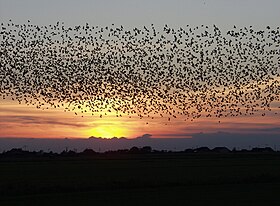| The population of birds |
|---|
 |
This article needs to be updated. The reason given is: New orders have been added and removed since this page was constructed. Some orders below are now invalid, and others are missing information.. (March 2023) |
This is a list of bird species by global population, divided by bird classification. While numbers are estimates, they have been made by the experts in their fields. For more information on how these estimates were ascertained, see Wikipedia's articles on population biology and population ecology. Contributing organizations include the IUCN, BirdLife International, and Partners in Flight.
The average global population of all mature birds is estimated to be on the order of 100 billion individuals.[1][2][3] The total population including younglings is somewhat higher during the breeding season of each species.[3]
This list is incomplete, because experts have not estimated all bird numbers. For example, the spectacled flowerpecker was only discovered in 2010, and did not receive its scientific name (Dicaeum dayakorum) until 2019,[4] adding to the other 73 new bird species described by ornithologists from 2000 – 2009.[5][6][7] Global population estimates for many of these at this time would lack accuracy.
All numbers are estimates, because they are taken by observation, and a given number of 50 slender-billed curlews does not necessarily mean there are 10 more of this species than the black stilt, which has been estimated at 40: there is a possibility that the latter species has a larger population than the former.[8][9] This list should not be taken that literally. An estimate of 250 shore dotterels compared with 4,500 – 5,000 wrybills, on the other hand, means that the latter has well over one order of magnitude more individuals than the former.[10][11] The wrybill only has approximately one tenth the population of great skuas (48,000), which are outnumbered ~10:1 by the pigeon guillemot (470,000).[12][13] It is these large differences between species that this list tries to convey.
- ^ Bar-On, Yinon M.; Phillips, Rob; Milo, Ron (2018-06-19). "The biomass distribution on Earth". Proceedings of the National Academy of Sciences. 115 (25): 6506–6511. doi:10.1073/pnas.1711842115. ISSN 0027-8424. PMC 6016768. PMID 29784790.
- ^ Gaston, Kevin J.; Blackburn, Tim M. (1997). "How many birds are there?". Biodiversity and Conservation. 6 (4): 615–625. doi:10.1023/A:1018341530497.
- ^ a b Gaston, K. J.; Blackburn, T. M.; Goldewijk, K. K. (2003-06-22). "Habitat conversion and global avian biodiversity loss". Proceedings of the Royal Society of London. Series B: Biological Sciences. 270 (1521): 1293–1300. doi:10.1098/rspb.2002.2303. ISSN 0962-8452. PMC 1691371. PMID 12816643.
- ^ Saucier, Jacob R.; Milensky, Christopher M.; Caraballo-Ortiz, Marcos A.; Ragai, Roslina; Dahlan, N. Faridah; Edwards, David P. (2019-10-17). "A distinctive new species of flowerpecker (Passeriformes: Dicaeidae) from Borneo". Zootaxa. 4686 (4): 451–464. doi:10.11646/zootaxa.4686.4.1. ISSN 1175-5334.
- ^ Reuters. "Spectacled flowerpecker" bird found in Borneo, scientificamerican.com, 13 January 2010, accessed on 15 January 2010.
- ^ Walton, Doreen, science reporter. New bird species found in rainforests of Borneo, BBC News, news.bbc.co.uk, 14 January 2010, accessed on 15 January 2010.
- ^ Pennak, Sara (18 January 2012). "State of observed species: A decade of species discovery in review" (PDF). Arizona State University: International Institute for Species Exploration. Archived from the original (PDF) on 31 October 2012. Retrieved 2013-01-02.
- ^ BirdLife International (2018). "Himantopus novaezelandiae". IUCN Red List of Threatened Species. 2018: e.T22693690A129560535. doi:10.2305/IUCN.UK.2018-2.RLTS.T22693690A129560535.en. Retrieved 20 November 2021.
- ^ BirdLife International (2018). "Numenius tenuirostris". IUCN Red List of Threatened Species. 2018: e.T22693185A131111201. doi:10.2305/IUCN.UK.2018-2.RLTS.T22693185A131111201.en. Retrieved 20 November 2021.
- ^ BirdLife International (2016). "Thinornis novaeseelandiae". IUCN Red List of Threatened Species. 2016: e.T22693899A93429618. doi:10.2305/IUCN.UK.2016-3.RLTS.T22693899A93429618.en. Retrieved 20 November 2021.
- ^ BirdLife International (2018). "Anarhynchus frontalis". IUCN Red List of Threatened Species. 2018: e.T22693928A131876706. doi:10.2305/IUCN.UK.2018-2.RLTS.T22693928A131876706.en. Retrieved 20 November 2021.
- ^ BirdLife International (2012). "Stercorarius skua". IUCN Red List of Threatened Species. 2012. Retrieved 2012-12-09.[permanent dead link]
- ^ BirdLife International (2018). "Cepphus columba". IUCN Red List of Threatened Species. 2018: e.T22694864A132578338. doi:10.2305/IUCN.UK.2018-2.RLTS.T22694864A132578338.en. Retrieved 20 November 2021.
